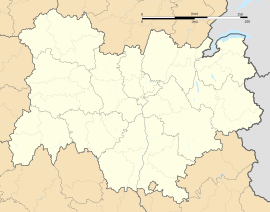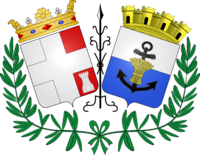Albertville facts for kids
Quick facts for kids
Albertville
Arbèrtvile (Arpitan)
|
||
|---|---|---|
|
Subprefecture and commune
|
||

A general view of Albertville
|
||
|
||
| Country | France | |
| Region | Auvergne-Rhône-Alpes | |
| Department | Savoie | |
| Arrondissement | Albertville | |
| Canton | Albertville-1 Albertville-2 |
|
| Intercommunality | CA Arlysère | |
| Area
1
|
17.54 km2 (6.77 sq mi) | |
| • Urban | 163.6 km2 (63.2 sq mi) | |
| Population
(2021)
|
19,812 | |
| • Density | 1,129.5/km2 (2,925.5/sq mi) | |
| • Urban
(2018)
|
39,780 | |
| • Urban density | 243.15/km2 (629.77/sq mi) | |
| Time zone | UTC+01:00 (CET) | |
| • Summer (DST) | UTC+02:00 (CEST) | |
| INSEE/Postal code |
73011 /73200
|
|
| Elevation | 328–2,030 m (1,076–6,660 ft) (avg. 352 m or 1,155 ft) |
|
| 1 French Land Register data, which excludes lakes, ponds, glaciers > 1 km2 (0.386 sq mi or 247 acres) and river estuaries. | ||
Albertville (French pronunciation: [albɛʁvil]; Arpitan: Arbèrtvile) is a subprefecture of the Savoie department in the Auvergne-Rhône-Alpes region in Southeastern France. It is best known for hosting the 1992 Winter Olympics and Paralympics. In 2018, the commune had a population of 19,214; its urban area had 39,780 inhabitants.
Contents
Geography
Albertville is one of two subprefectures of the Savoie department, alongside Saint-Jean-de-Maurienne.
Albertville is situated on the river Arly, close to the confluence with the river Isère. Its altitude ranges from 345 to 2,037 metres (1,132 to 6,683 ft). Nearby mountains include: Belle Étoile, Dent de Cons, Négresse, Roche Pourrie, Mirantin, Pointe de la Grande Journée, Chaîne du Grand Arc. Nearby mountain ranges include the Bauges, the Beaufortain and the beginning of the Vanoise.
History
The modern city of Albertville was formed in 1836 by King Charles Albert of Sardinia, who merged the medieval town of Conflans, which had buildings dating to the 14th century, with the town of L'Hôpital. Since then, Albertville has fostered trade between France, Italy and Switzerland. Industries such as paper mills and hydroelectricity are found along its river.
The 1992 Winter Olympics were organised in the Savoie region, with Albertville hosting it. Some of the sports venues were later adapted for other uses. Some sports venues still remain, such as the ice rink, La halle de glace Olympique, designed by the architect Jacques Kalisz. Despite this, the town remains more industrial than touristic.
In 2003, the town was labelled a "Town of Art and History".
Population
| Historical population | ||
|---|---|---|
| Year | Pop. | ±% p.a. |
| 1968 | 15,739 | — |
| 1975 | 16,961 | +1.07% |
| 1982 | 16,970 | +0.01% |
| 1990 | 17,411 | +0.32% |
| 1999 | 17,340 | −0.05% |
| 2007 | 17,814 | +0.34% |
| 2012 | 19,271 | +1.58% |
| 2017 | 18,899 | −0.39% |
| Source: INSEE | ||
Transport
Albertville station was put into service in 1879 by the Compagnie des chemins de fer de Paris à Lyon et à la Méditerranée (PLM).
Notable people
- Justine Braisaz (born 1996), Olympic champion and world medalist in biathlon
- Jean-Luc Crétier (born 1966), Olympic champion in alpine skiing (WOC 1998, downhill)
- Florine De Leymarie (born 1981), skier
- Jérôme Jarre (born 1990), comedian on the Vine app
- Léa Lemare (born 1996), ski jumper and national champion
- Lucette Mazzella (1910–1987) teacher, communist organizer and women's rights activist
- Gérard Mourou (born 1944), Nobel Prize winner in Physics, 2018
- Julia Simon (biathlete) (born 1996), world champion in biathlon
Sites of interest
- La halle de glace Olympique, or the Olympic ice hall, the ice arena that hosted events during the 1992 Winter Olympics.
- L'anneau de vitesse, or speed oval, the athletic stadium that previously served as the site of the speed skating competitions of 1992 Winter Olympics.
International relations
Albertville is twinned with:
 Aosta, Italy
Aosta, Italy Winnenden, Baden-Württemberg, Germany
Winnenden, Baden-Württemberg, Germany Sainte-Adèle, Quebec, Canada
Sainte-Adèle, Quebec, Canada Vancouver, British Columbia, Canada, which like Albertville, hosted a Winter Olympics, doing so in 2010
Vancouver, British Columbia, Canada, which like Albertville, hosted a Winter Olympics, doing so in 2010
Heraldry
See also
 In Spanish: Albertville para niños
In Spanish: Albertville para niños






